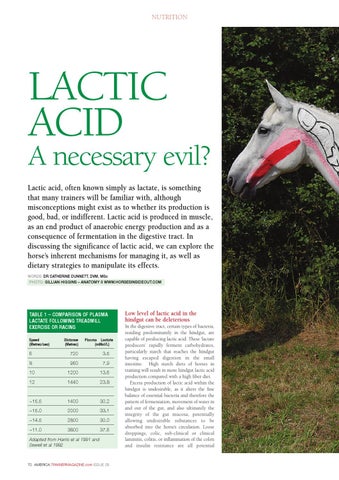LACTIC ACID REVISED ISSUE 28_Jerkins feature.qxd 16/04/2013 22:08 Page 1
NUTRITION
LACTIC ACID
A necessary evil? Lactic acid, often known simply as lactate, is something that many trainers will be familiar with, although misconceptions might exist as to whether its production is good, bad, or indifferent. Lactic acid is produced in muscle, as an end product of anaerobic energy production and as a consequence of fermentation in the digestive tract. In discussing the significance of lactic acid, we can explore the horse’s inherent mechanisms for managing it, as well as dietary strategies to manipulate its effects. WORDS: DR CATHERINE DUNNETT, DVM, MSc PHOTO: GIllIAN HIGGINS – ANATOMy II WWW.HORSESINSIDEOUT.COM
Table 1 – Comparison of plasma laCTaTe following Treadmill exerCise or raCing speed (metres/sec)
distance (metres)
plasma lactate (mmol/l)
6
720
3.5
8
960
7.9
10
1200
13.6
12
1440
23.8
~15.5
1400
30.2
~15.0
2000
33.1
~14.5
2800
30.0
~11.0
3800
37.6
Adapted from Harris et al 1991 and Sewell et al 1992
70 AMERICA.TRAINERMAGAZINE.com ISSUE 28
Low level of lactic acid in the hindgut can be deleterious In the digestive tract, certain types of bacteria, residing predominantly in the hindgut, are capable of producing lactic acid. These ‘lactate producers’ rapidly ferment carbohydrates, particularly starch that reaches the hindgut having escaped digestion in the small intestine. High starch diets of horses in training will result in more hindgut lactic acid production compared with a high fiber diet. Excess production of lactic acid within the hindgut is undesirable, as it alters the fine balance of essential bacteria and therefore the pattern of fermentation, movement of water in and out of the gut, and also ultimately the integrity of the gut mucosa, potentially allowing undesirable substances to be absorbed into the horse’s circulation. Loose droppings, colic, sub-clinical or clinical laminitis, colitis, or inflammation of the colon and insulin resistance are all potential
